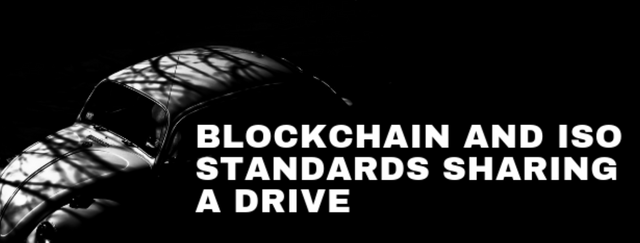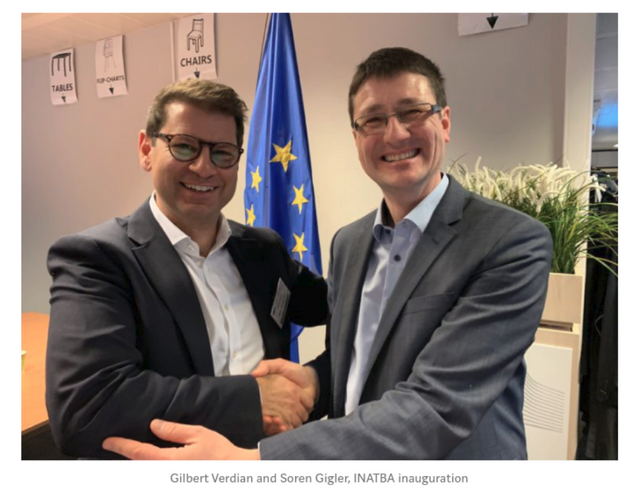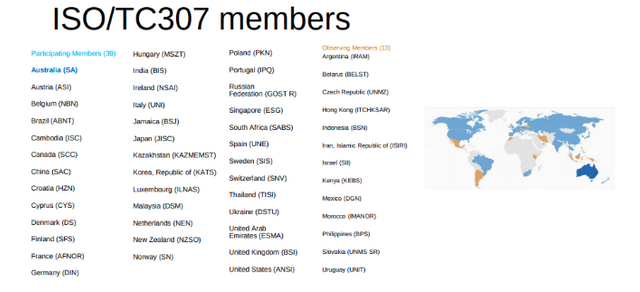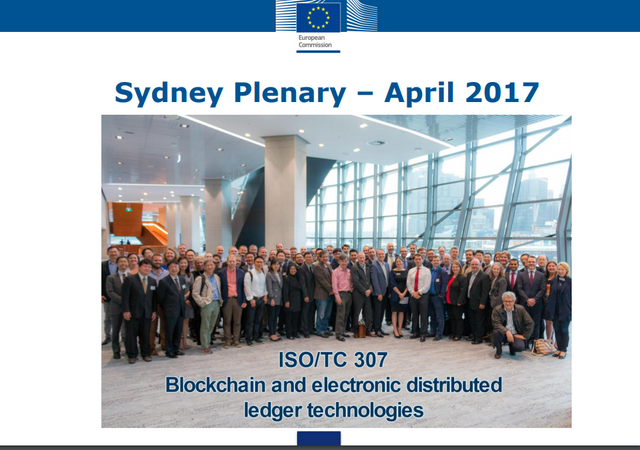Blockchain is getting attention via cooperation with ISO standards
Blockchain is getting attention via cooperation with ISO standards

This article gives you an introduction to what ISO is about, describes the cooperation between the ISO party and the blockchain project, and provides information on how blockchain technology works
Introduction
Much like the roads need traffic lights and modern states would not work without the rule of law, every important aspect in the fields of technology, economy, health care, and medicine needs ISO standards. These standards declare the correct limits, values, procedures, quality evaluation methods, and many others.
ISO Standards are a key part of our society as they ensure quality and safety in both products and services in international trade. ISO standards benefit businesses by cutting costs through improved systems and procedures.
Similarly, governments can benefit greatly from ISO standards, as these can support common good by providing expert-approved global norms, and thus also pave the way to the global exchange of goods and ideas. Many governments, therefore, implement international standards and integration of ISO standards, which ensures transparency for trading parties world-wide.
The first interaction with the ISO world for many industries was a requirement to attain ISO 9001, Total Quality Management, in 2015. ISO 9001 is the stamp of approval indicating that a company is following good practices and procedures usually in the manufacturing industry.
These days, we can again hear or read about ISO standards and its because a rising cardinality of ISO mentions right next to another technological chapter of the 21st century, a blockchain.
Importance of standards - a summary
• Goal: Enabling ecosystems through interoperability
• Challenge: Anticipating technology trends and their impact on applications
“Trusted standards mean that industry doesn’t need to reinvent the wheel, that innovations will be compatible and work with existing technology, and that products and services will be trusted, too. Governments use standards as trusted solutions to complement regulation, and they give peace of mind to consumers who know they are not putting themselves or their families at risk.” - Acting ISO Secretary-General Kevin McKinley
To extend the above wheel analogy further, the uses of the wheel as an instrument were initially very limited, but eventually, it permeated every aspect of the industrial revolution and the world it created. In many ways, the internet is the new wheel, and the blockchain works as its pneumatic tire - an enhancement to make the wheel even more useful and ubiquitous.
Nevertheless, there is still some uncertainty about how innovative an aspect this technology can prove for the IT infrastructure of the future. A lot will depend on what can be built on or around the blockchain technology. Implementing blockchain-based solutions to systems that deliver ISO standards globally is a great step towards adopting the blockchain technology thoroughly.
Some may still not believe that blockchain could ever transcend the pitfalls of being "just another technological buzzword". However, since this technology is starting to permeate areas like the ISO, banking, or identity protection, many have already started paying closer attention.
Blockchain is a cryptography-focused architecture based on the Internet protocol and powered by networked computer servers that do not need to be set up by developers.
That is, however, just one of its many attractive features.
In addition, a blockchain is a software approach designed to bind this hardware together and dedicate it to the Consensus, a universal validity check system that, among others, uses the Proof of Work (PoW) and Proof of Stake (PoS) methods for validation, and is the primary layer of any decentralized verification architecture.
In many respects, blockchain can be considered a meta-technology, since it utilizes, enhances, and potentially supersedes other, already existing, software technologies. As such, it allows us to create versatile technological solutions that aim to minimize the agency of third-party providers and, in a way, to return the power back to the users. This can be achieved by the blockchain providing an environment where users can interact freely in a trustless ecosystem for very low to almost-zero fees and at speeds that make everybody in the world reachable in a matter of minutes.
To make that possible, the blockchain can also be used as a transaction platform and distributed accounting ledger that uses cryptocurrency tokens (digital money) as a demonstration of a specific value at the current time (much like traditional fiat currencies).
Nevertheless, for trustless technology to work on a global scale, it needs to implement trust in a different manner. This is where ISO standards come into the picture, as they ensure that the blockchain interactions follow globally applicable rules, norms, and procedures. This is also why starting in 2016, blockchain has its own set of ISO standards, called ISO/TC307.
Gilbert Verdian and ISO/TC307
Gilbert Verdian drove the initiative to develop a Blockchain ISO Standard, eventually approved in October 2016 as ISO/TC307 - BLOCKCHAIN AND DISTRIBUTED LEDGER TECHNOLOGIES. 35 countries and organizations were involved in the completion of this project.

ISO/TC 307 currently operates in structure cells that are created and disbanded when needed.
ISO/TC 307/CAG 1 Convenors coordination group
ISO/TC 307/JWG 4 Joint Working Group with ISO/IEC JTC 1/SC 27 WG
ISO/TC 307/SG 2 Use cases
ISO/TC 307/SG 6 Governance of blockchain and distributed ledger technology systems
ISO/TC 307/SG 7 Interoperability of blockchain and distributed ledger technology systems
ISO/TC 307/WG 1 Foundations
ISO/TC 307/WG 2 Security, privacy and identity
ISO/TC 307/WG 3 Smart contracts and their applications
The proposal of this standard is the standardization of blockchains and distributed ledger technologies to support interoperability and data interchange among users, applications, and systems.
Gilbert Verdian is the current chairman of the ISO National Committee on Blockchain for the UK.

ISO/TC307 tools
LiveLink - a portal for all documents, email communications, a forum, and even a list of members who are registered for a particular working group.
N-docs - documents that are assigned with sequential numbering for ease of reference.

Other relevant standardization efforts next to ISO/TC307
ITU-T Focus Group on Application of
Distributed Ledger Technology
IEEE Blockchain initiative
CEN/CENELEC Focus Group on Blockchain and DLT
Rick Schmitz - Blockchain as an ISO integrator
The paragraphs below provide an example of blockchain-based solutions and a company that delivers ISO standards in mutual collaboration.
In August 2019, there was a collaboration agreement signing by LTO Network's Rick Schmitz and NEN, the Dutch Standardization Institute.
By utilizing LTO Network's hybrid blockchain, NEN has become one of the first standardization agencies around the world to store hashes of standardization certificates on the blockchain in a decentralized manner.
The decentralized solution created by this fusion delivered an instant verification of certificates provided by NEN using patented smart QR codes, hashes of which are safely stored on the LTO blockchain which is currently 23th most used blockchain (source - Blockchain Activity Matrix). Stakeholders can then use the QR codes to confirm the validity of any certificate issued by NEN in a matter of seconds. Changes to the certificates will be automatically reflected in their QR codes, which are then re-hashed on the blockchain to safeguard the validity of the certificate’s current state. Any possible tampering with these QR codes will make them out-of-sync with the data stored on the blockchain, and they will, therefore, be found invalid by the parties involved.
Why is blockchain a good solution?
Traditionally, electronic security focuses on authorization, authentication, and access control. These mechanics are intended to keep unauthorized users from accessing or modifying data. However, when it comes to authorized access, either on application or system level, it does not provide any protection. Blockchain enables tamper resistance for data through distribution over many systems that are run and managed by independent parties.
This is ensured by the architecture of the blockchain, where every piece of data has thousands of globally distributed copies. A potential attacker intent on breaching the certificate would have to compromise the majority of the data distribution at the same time, which is extremely hard, expensive, and with a well-designed blockchain almost impossible.
To reiterate, blockchain is a versatile solution for a variety of real-world use cases, and it is up to innovative minds how soon and how extensively this “pneumatic tire” of the internet will be used for the betterment to many walks of the modern life.
The End
References
Basic ISO use cases
- Getting government tenders: ISO certificate is now required in the majority of government tenders.
- Building credibility internationally: ISO Certification helps your organization with credibility to build an overseas business.
- Greater customer satisfaction: ISO standards are designed to enable an organization to serve their customers better and hence increase customer satisfaction. ISO certification enhances customer satisfaction by meeting customer requirements.
- Improving product quality: Since product quality matches the international level, this can reduce the risk of order rejections that can occur due to a flaw in the product.
- Improving business efficiency: ISO certification implementation enhances the functional efficiency of an organization. The ISO Certification agency helps you develop SOPs & work instructions for all your processes. ISO implementations help manage the resources effectively, as you become able to utilize all your resources to the maximum extent.
- Improving marketability: ISO certification helps improve the credibility of business with a current & new client, which leads to creating a niche market for business. Source - Quora
About NEN
The Netherlands Standardization Institute (NEN) is a center of standardization that helps parties adhere to established standards and terms of conduct, and to agree on clear and usable terms. NEN also helps Dutch companies and parties make agreements with other organization at an international level.
NEN’s business activities include European and national standardization, investigating, issuing certificates, training and consulting about international standards, and maintaining the infrastructure required for drawing up these standards.
About LTO Network
LTO Network is a member of the blockchain standards committee (as well as an ISO/ TC 307 contributor) and the International Association for Trusted Blockchain Applications (INATBA).
LTO Network develops and provides a Toolkit for Trustless Workflows (as a product/service). It is a solution that automates workflows in the business-to-business (B2B) market by making them trustworthy between each party.
To execute this, they split up their solution into a Hybrid Chain with two different layers.
The second layer uses permissionless private chains, which utilize LTO “Live Contracts”. The “Live Contract” is like a workflow to automate processes (for example, a customer who applies within a KYC, which is getting signed by the company).
The information about this event happening gets hashed (saved within the cryptographic algorithm) on the first layer, which acts then as the security layer. All of this is possible by connecting legacy systems that the parties already use, making integration of a blockchain seamless/fluent.
About Quant Network
Quant Network is a UK company, based in London, which developed the world’s first blockchain operating system known as Overledger, a system that interconnects blockchains and existing networks, facilitating the creation of internet-scale multi-chain applications. Their project has a token, QNT which is integral to its Overledger platform and the demand for which will increase as usage through the system increases.
The company is founded and led by Gilbert Verdian , a technologist with over 20 years of industry experience working in an enterprise, finance, government and financial entities such as HSBC and Mastercard.
Yes i agree with point there is need of ISO certification .
ISO 27001 is an international standard on how to manage information security. ISO refers to the International Organization for Standardization.
ISO 270001 Certification is needed in this modern era. Training and certification will give an itemized comprehension of review philosophy including meeting methods, inspecting hazard appraisals, guaranteeing fitting restorative activity, and rehearsing new aptitudes.
The value for this certificate is more in the corporate world
ISO 27001 was developed to help organizations, of any size or any industry, to protect their information in a systematic and cost-effective way, through the adoption of an Information Security Management System (ISMS).
Achieving accredited certification to ISO 27001 demonstrates that your company is following information security best practice, backed by an independent, expert assessment of whether your data is adequately protected. ISO 27001 is supported by its code of practice for information security management, ISO/IEC 27002:2013.
I have one reference from my colleagues where you can do ISO 27001 lead auditor certification course with training. This course is from GSDC. The ISO 27001 lead auditor certification cost course is affordable. This certification is valid for lifetime and accepted globally. You can check the given link below :
https://www.gsdcouncil.org/certified-iso-27001-lead-auditor